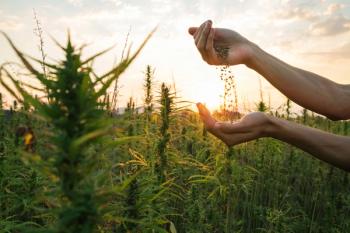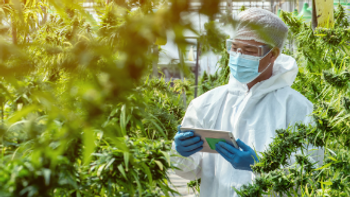
The Drive for Sustainability in Cannabis Cultivation Practices

As cannabis reform and acceptance expands in the US, so does its impact on the environment. In the rapidly evolving landscape of cannabis cultivation, one organization is looking toward more sustainable and ethical approaches to cannabis growing. Launched in 2019, Sun+Earth Certified is a nonprofit, third-party certification for organic cannabis, supported by a community of growers and educators advocating for regenerative cannabis farming practices to benefit local and global communities. In this interview, Heather Dunbar, Director of Marketing and Communications, shares her journey into the cannabis industry, the vital role of Sun+Earth Certified in reshaping cannabis cultivation practices, and the organization's vision for a more environmentally conscious and socially responsible future.
Can you tell us about your role with Sun+Earth Certified and how you became involved in this area of the cannabis industry?
Heather Dunbar: I am a longtime advocate, educator, and consumer of cannabis and believe wholeheartedly in this plant for medical and environmental reasons.
I have worked in the natural products industry and have been a part of the organic food movement for two decades. I have also danced in the cannabis industry well before we called it such a thing. I have been involved in various aspects of the legalized market since its conception, mostly as a voice for the small-scale farmer educating the consumer on the importance of how cannabis is grown and the impact it has on the environment and local communities.
I have been working with Sun+Earth Certified since its launch in 2019 and currently serve as the Director of Marketing and Communications. It is, in part, my job to communicate the value and benefits of regenerative organic cannabis through various marketing campaigns, consumer education, and public relations. I get to visit a lot of amazing regenerative organic cannabis farms too!
Cannabis consumers have a right to know the impact of their purchasing decisions. Currently, there are no regulations that require a cultivator to disclose how their cannabis was grown—metrics like pesticide concentration, or energy use, which relates to a farm’s carbon footprint, or even the social impact of their cultivation practices. Growing cannabis regeneratively, under the sun, drastically reduces the impact the plant has on the environment. Sun+Earth Certified is a way to verify and differentiate cannabis products in the marketplace—products that are good for people and planet.
Can you tell us about your work with organic and natural products and your contributions to the 2017 book CBD: A Patient's Guide to Medical Cannabis (1)?
Dunbar: Many years ago, I realized that business can be used as a force for good and can have a positive impact on people and the planet. My undergraduate education was focused on nutrition and holistic health, which directed me to the organic food movement where I eventually began working with companies in the natural products industry who carry the ethos of a social enterprise. This is where I met David Bronner, the CEO of Dr. Bronner’s Soap, who helped launch Sun+Earth Certified. Later, I began working with a pioneering cannabidiol (CBD) company and educating consumers about cannabis and its medicinal properties and applications. This all led to having the privilege of sharing some of my knowledge, as a contributing author, to the 2017 publication CBD: A Patient's Guide to Medical Cannabis.
According to the Sun+Earth Certified website (2), the three pillars of the organization are Earth Care and Cultivation, Human Empowerment, and Community Engagement. Why are these particular focuses considered essential for growing cannabis?
Dunbar: The three pillars of our nonprofit certification represent a standard that is beyond United States Department of Agriculture (USDA) Organic—a standard that includes people and communities. It is not just about inputs on the ground. It’s also about treating people fairly and giving back to your neighboring community. The organic food movement failed for many years to ensure that the treatment of farmworkers was central. This is why the fair-trade movement came into being—to ensure that workers are treated fairly and have access to a living wage.
The first pillar—Earth Care and Cultivation—guarantees that Sun+Earth Certified cannabis is grown using regenerative organic farming practices without the application of pesticides and other toxic chemicals. The second two pillars focus on people: ensuring that workers have reasonable workplace conditions and the right to a living wage and community engagement, which ensures that farmers engage with and give back to their respective communities. Sun+Earth puts equal weight on each of these three pillars. It’s not just about regenerative cultivation practices, but also workers and local communities.
What are some of the benefits of becoming Sun+Earth Certified?
Dunbar: The benefits of becoming Sun+Earth Certified include being part of a movement and a community that grows cannabis the way nature intended—under the sun, in the soil, by fairly paid farmers. The Sun+Earth farming community has a wealth of shared knowledge around growing techniques to build soil vitality, as well as methods to guard against wildfires and droughts. We are part of a pioneering movement to define quality cannabis, measure the impacts and communicate the value proposition of sungrown, regenerative organic cannabis.
Sun+Earth also defends and supports the certified farms in its community. Last year, we launched
Most of the current certified farms and participating dispensaries seem to be on the West Coast. Are there plans to encourage other parts of the country to join? What about international expansion?
Dunbar: This year, Sun+Earth has certified more than 70 farms and manufacturers in four US states—California, Michigan, Oregon, and Washington. Many Sun+Earth Certified farms are second and third generation cannabis farmers as a result of the modern-day cannabis movement having roots in the back-to-the-land movement of the 1960s. And while the vast majority of our certified farms are on the West Coast, we are looking to expand into the Northeast US. We are proud to announce that we will soon be certifying our first farm on the East Coast, in Vermont. Earlier this year, we certified our first Canadian farm in British Columbia. Our vision is to continue expanding our regenerative organic reach to communities across the county and around the world.
If a cannabis farm wanted to reduce its negative impact on the environment, where is the best place to begin?
Dunbar: If we want to reduce our negative impact on the environment, we should grow cannabis outside, under the sun, and in the soil. Compared to large-scale mono-crop operations, regeneratively organic cannabis lessens the industry’s impact on climate change and eliminates toxic chemicals that negatively impact the soil, water and air. Other regenerative organic practices that positively impact the environment include crop rotation, cover cropping, no-till farming, and making one’s own compost onsite. Every step of the way counts and by closing the loop as much as possible, we will reduce impact cumulatively.
Hypothetically speaking, if a majority of cannabis cultivation switched from conventional to regenerative practices, what do you envision the biggest changes in the industry with this scenario?
Dunbar: If the cannabis industry switched to regenerative organic agriculture tomorrow, we would see a tremendous reduction in energy use and, by extension, the industry’s carbon footprint. The industry would be a model for how to effectively limit the impacts of climate change. With no toxic chemicals used to cultivate cannabis, millions of consumers would lead healthier lives. By incorporating regenerative organic farming practices, untold acres of farmland would become revitalized and sustainable for generations to come, benefiting not only individual farms, but also the neighboring communities. At the end of the day, we all live downstream.
What are the plans for the future? Will the organization be expanding into creating certification for psychedelic mushrooms?
Dunbar: Sun+Earth is part of a regenerative organic agricultural movement with farming practices that can be applied across the board, but we will be focusing on cannabis with no immediate plans to expand our certification to include additional plant medicines.
What is one fact or story that you would like to share with anyone interested in cultivation?
Dunbar: According to a
The data is clear: if you want to reduce your carbon footprint, choose regenerative organic sungrown cannabis!
References
- Leinow, L. and Birnbaum, J. CBD: A Patient's Guide to Medical Cannabis, North Atlantic Books, Berkeley, California, 2017.
https://sunandearth.org/ https://www.weedlikechange.org - Mills, E., The Carbon Footprint of Indoor Cannabis Production, July 2012, Energy Policy 46.DOI:
10.1016/j.enpol.2012.03.023 . - Summers, H.M., Sproul, E., and Quinn, J.C., The greenhouse gas emissions of indoor cannabis production in the United States, Nature Sustainability, 2021, 4, 644–650.
Newsletter
Unlock the latest breakthroughs in cannabis science—subscribe now to get expert insights, research, and industry updates delivered to your inbox.



